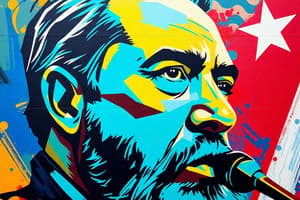Podcast
Questions and Answers
What was the date that the fragile democracy of Cuba came to an end with a coup d'etat orchestrated by Fulgencio Batista?
What was the date that the fragile democracy of Cuba came to an end with a coup d'etat orchestrated by Fulgencio Batista?
March 10, 1952
Who was Fulgencio Batista, and what did he do to take power in Cuba?
Who was Fulgencio Batista, and what did he do to take power in Cuba?
Fulgencio Batista was a former president of Cuba who orchestrated a coup d'etat in 1952 to take power, despite being a distant third in the upcoming presidential election.
How did the United States respond to Batista's coup and dictatorship in Cuba?
How did the United States respond to Batista's coup and dictatorship in Cuba?
The United States supported Batista's military dictatorship, as they had massive financial interests in Cuba and wanted to ensure the flow of dollars, even though this alienated Cubans and others across Latin America who saw the US as an imperialist power.
Who was Fidel Castro, and what was his role in the emerging resistance movement against Batista's dictatorship?
Who was Fidel Castro, and what was his role in the emerging resistance movement against Batista's dictatorship?
What publication did Fidel Castro use to help organize the resistance against Batista's regime?
What publication did Fidel Castro use to help organize the resistance against Batista's regime?
What was the significance of the Cuban Revolution during the Cold War period?
What was the significance of the Cuban Revolution during the Cold War period?
What is the host's name mentioned in the passage?
What is the host's name mentioned in the passage?
What is the main purpose of Squarespace, the sponsor of the video?
What is the main purpose of Squarespace, the sponsor of the video?
What are some of the key features of Squarespace's website-building platform mentioned in the passage?
What are some of the key features of Squarespace's website-building platform mentioned in the passage?
Flashcards are hidden until you start studying
Study Notes
The Coup in Cuba
- On March 10, 1952, Fulgencio Batista orchestrated a coup d'etat in Cuba, ending the country's fragile democracy.
- Batista, who had been President of Cuba from 1940 to 1944, was polling third in the general elections scheduled for June 1952 and decided to take power by force to avoid defeat.
Batista's Rule and US Support
- Batista established a military dictatorship in Cuba, which was supported by the United States due to its significant financial interests in the country (utilities and sugar cane industry).
- The US supported Batista's regime to maintain peace and ensure the flow of dollars.
Rise of Fidel Castro
- Fidel Alejandro Castro Ruz, a young lawyer from a wealthy Cuban family, emerged as a key figure in the resistance against Batista's regime.
- Castro had been politically active since the late 1940s as a member of the left-wing populist Partido Ortodoxo and had been running as a candidate in the cancelled 1952 elections.
- The establishment of Batista's dictatorship led Castro to conclude that revolution was the only way to remove the military regime.
Castro's Early Efforts
- Castro began to organize a revolution, recruiting people who could lead a guerrilla warfare campaign against the Batista regime.
- He published and circulated a newsletter called El Acusador (The Accuser) to gain support.
- Castro gathered around 1,500 activists, including disillusioned members of the Partido Ortodoxo and student leaders from universities in Cuba.
- His followers donated guns and other necessary weapons for the revolution.
Studying That Suits You
Use AI to generate personalized quizzes and flashcards to suit your learning preferences.




